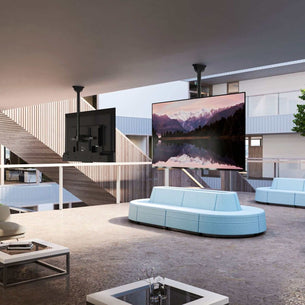Why Optimal TV Height Makes All The Difference
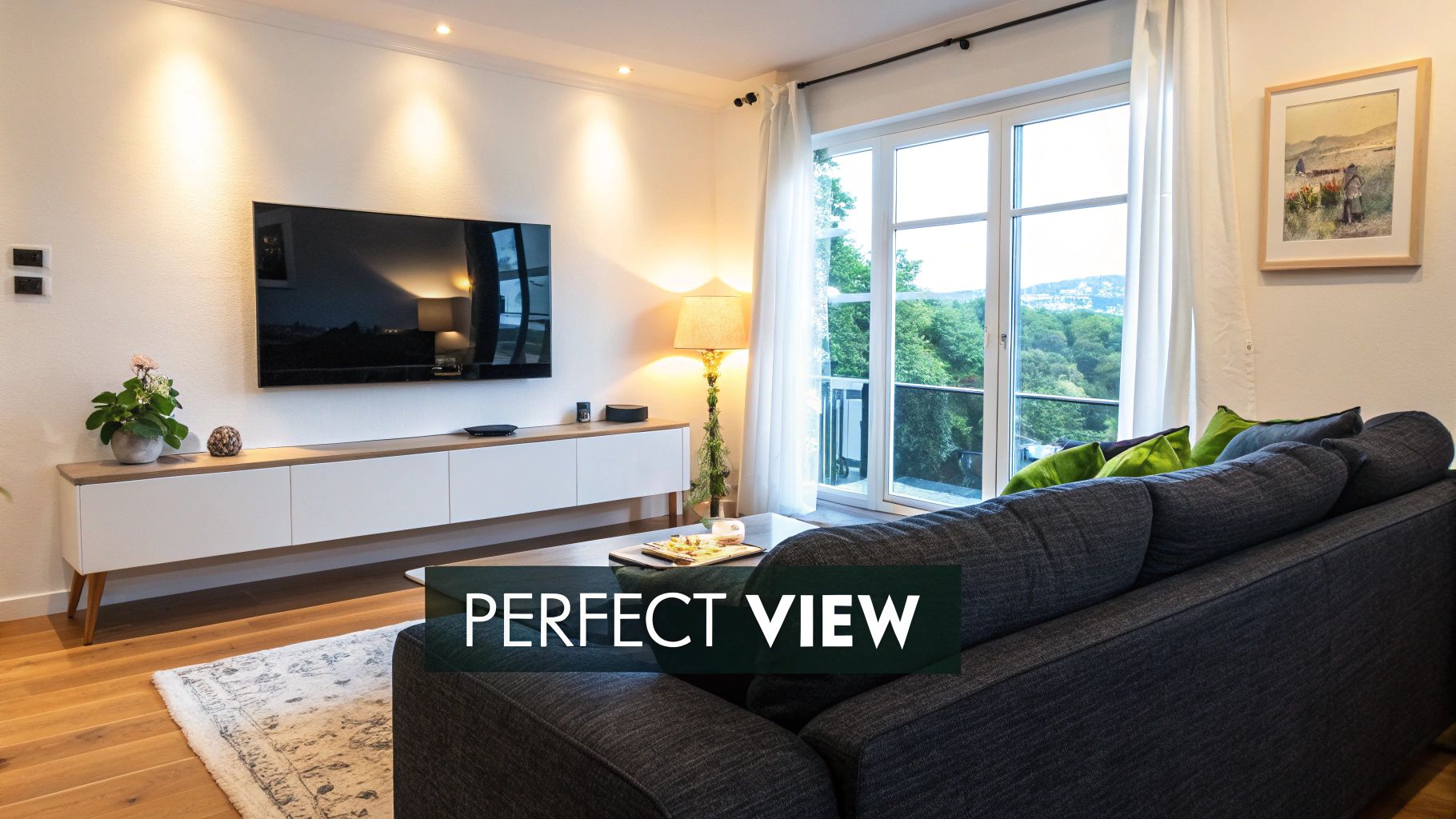
Incorrect TV placement is a surprisingly common issue that can drastically affect your viewing experience. Finding the optimal height for your TV is about more than just aesthetics; it’s crucial for comfort and enjoyment. A poorly positioned screen can lead to several problems, including neck and eye strain, and awkward viewing angles that diminish the quality of your entertainment.
The Hidden Costs of Poor Placement
Think about those movie nights where everyone fights for the "best" seat. The one where you don’t have to crane your neck or squint. This often indicates a TV height problem. Mounting a TV too high forces viewers to tilt their heads upwards, causing neck pain and eye fatigue.
A TV placed too low can create similar discomfort, requiring viewers to look down for extended periods. This can ruin movie marathons and even lead to long-term problems. Glare and reflections from a poorly placed TV can also worsen the viewing experience.
Real-World Examples of TV Height Gone Wrong
The classic example of a TV height disaster is placing it above the fireplace. While visually appealing to some, this almost always results in an uncomfortable viewing angle. Another common mistake is centering the TV on the wall without considering the viewer's eye level from the seating area. This might look balanced, but often results in a screen that’s too high for comfortable viewing.
Even small adjustments can make a big difference. Lowering a TV just a few inches can significantly improve comfort and enjoyment.
The Science Behind Comfortable Viewing
The optimal TV height is all about ergonomics and viewing angles. The goal is a natural viewing experience where your eyes rest near the center of the screen without strain. This reduces eye fatigue and neck pain, allowing for greater immersion. You might be interested in: How to master workplace ergonomics.
A key factor is the viewer's eye level, which should ideally align with the center of the screen. If the viewer's eye level is 36 inches from the floor, adding approximately 22% of the viewing distance to this height can create a comfortable experience.
For example, with a 65-inch TV viewed from 9 feet away, the TV's center point should be about 60 inches from the floor. Explore this topic further here. This ensures you avoid straining your neck or eyes, creating a far more enjoyable experience.
Finding Your Perfect TV Height (The Smart Way)
Forget guesswork. Let's ditch the approximations and dive into the proven methods professionals use to determine the optimal TV height. We'll break down those industry-standard calculations, guiding you through accurate measurements, seating arrangements, and even those tricky situations like recliners or multi-level seating. We’ll also tackle why the 'eye-level rule' isn't always the best approach and explain why viewing distance is so critical.
Measuring Your Space and Seating
First, accurately measure the distance between your main viewing spot and the wall where your TV will be mounted. This viewing distance is key to the entire process. Next, measure the height of your eyes from the floor while seated in your typical viewing position. This is your eye-level height. Having both measurements sets the stage for accurate calculations.
Calculating the Optimal Height
A common guideline suggests the center of your TV screen should be roughly 22% of the viewing distance above your eye level. For example, if your eye level is 40 inches from the floor and your viewing distance is 8 feet (96 inches), the center of your screen should be about 40 inches + (96 inches * 0.22) = 61 inches from the floor.
Check out our guide on How to master TV mounting for more details on calculations and specialized scenarios.
Visualizing the Relationship
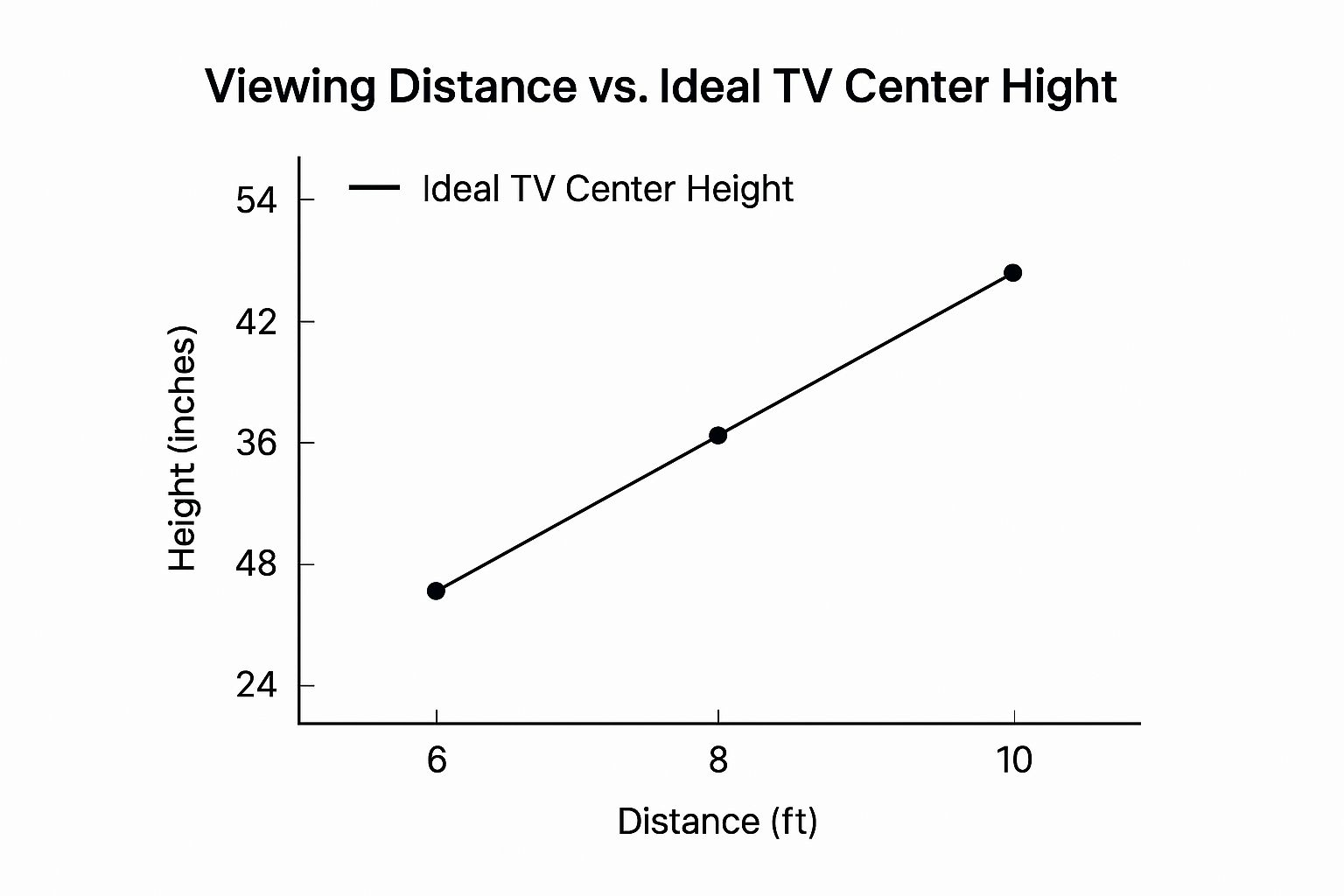
This infographic helps visualize the connection between viewing distance and ideal TV center height. It clearly shows how a greater distance usually needs a higher mounting position. As the infographic demonstrates, the ideal TV height gradually increases as your viewing distance expands, ensuring comfortable viewing no matter your room’s setup.
The following table provides some examples of how these calculations translate to real-world scenarios:
TV Height Calculator by Screen Size and Distance Quick reference table showing optimal mounting heights for different TV sizes and viewing distances
| TV Size | Viewing Distance | Eye Level Height | Optimal TV Center Height |
|---|---|---|---|
| 55" | 8 ft (96 in) | 40 in | 61 in |
| 65" | 10 ft (120 in) | 42 in | 68 in |
| 75" | 12 ft (144 in) | 44 in | 76 in |
This table illustrates how the optimal TV center height increases with both viewing distance and a typical increase in eye-level height associated with larger seating arrangements for larger TVs. Remember these are just examples, and your own calculations based on your specific measurements are crucial for the best results.
Adapting to Different Seating
The ideal height isn't a one-size-fits-all solution. Think about what kind of seating you have. Do you have a recliner, where your eye level shifts when you lean back? Or maybe multi-level seating, like a sofa and a higher armchair? In these cases, focus on the most frequently used seating position. Another approach is to find a middle ground – a height that works reasonably well for everyone.
Handling Tricky Situations
Some room layouts present extra challenges. Fireplaces often position TVs too high for comfortable viewing. If this is your situation, consider tilting your TV downwards for a more natural viewing angle. Unusual room shapes can also require adjustments to the standard calculations. A corner installation, for instance, may need a slightly higher mount to ensure clear visibility.
The Importance of Flexibility
Remember, the calculated height is just a starting point. Once your TV is mounted, check how comfortable it feels from different seating positions. Even small tweaks can make a big difference. Consider using an adjustable mount, which gives you the flexibility to fine-tune the height after installation. This is especially helpful if your furniture or viewing habits change over time. Regularly checking your setup is also important to make sure the TV height remains optimal for your needs. Following these tips can create a comfortable and enjoyable TV experience for everyone.
How TV Technology Changed The Height Game
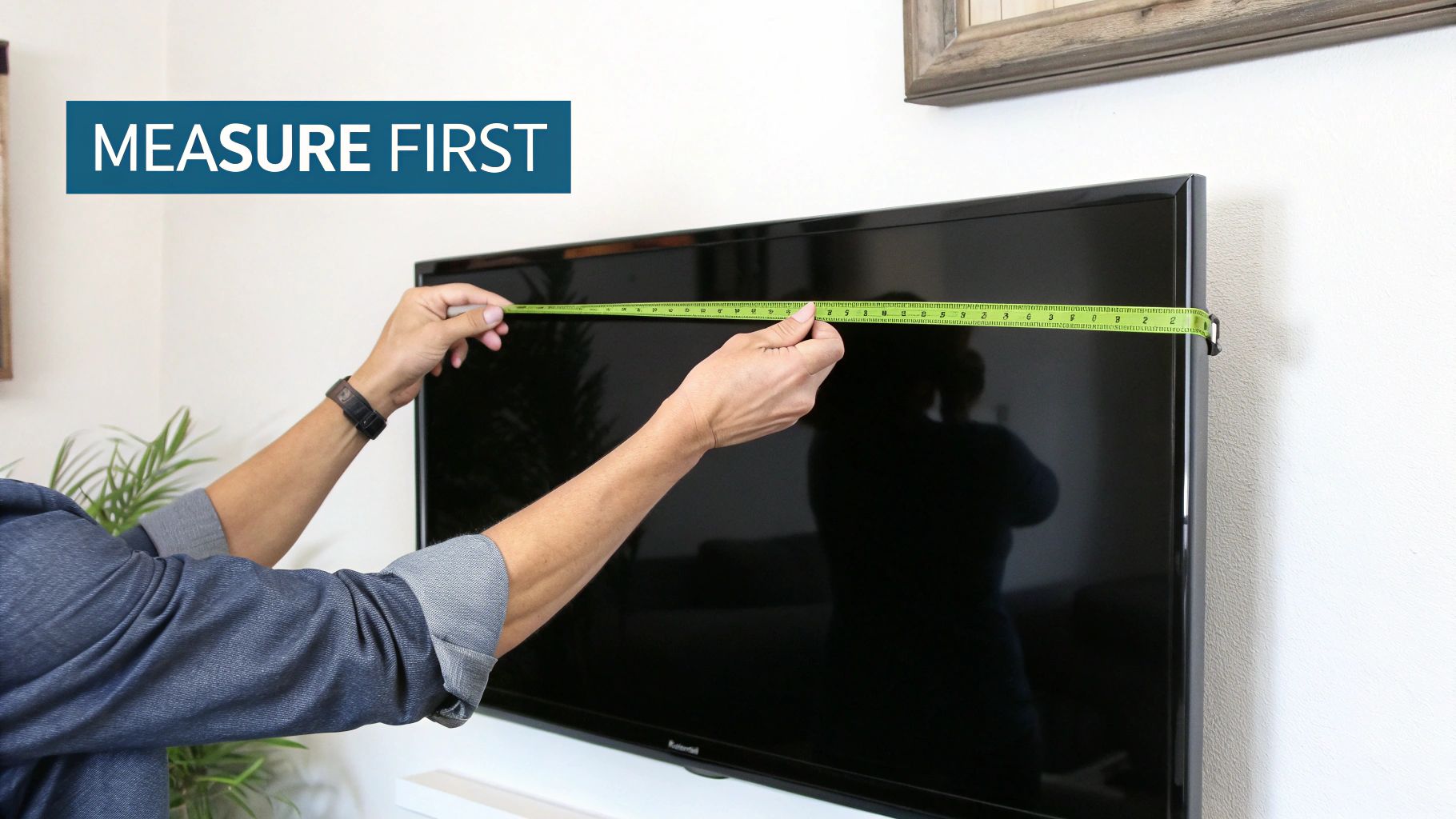
Remember those bulky CRT televisions? They were practically furniture, often perched on large entertainment centers. This naturally resulted in a higher viewing position, a stark contrast to today's sleek setups. The evolution of TV technology has significantly impacted how we position our screens for optimal viewing.
From CRT to Flat Screens: A Shift in Viewing
Older CRT televisions, with their considerable depth and weight, often dictated a higher placement on stands or entertainment centers. The introduction of flat-screen technologies like LCD and plasma changed everything. These slimmer, lighter TVs opened up new possibilities, making wall-mounting a popular choice and shifting the focus to finding the perfect height for these new displays.
The Rise of HD and Beyond: Impact on Viewing Angles
The change wasn't just about size and weight. High-definition (HD) and later 4K resolution transformed how we interact with our TVs. The enhanced clarity of higher resolutions allows for closer viewing distances. This shift impacted the optimal viewing angle and, consequently, the ideal TV height. The Society of Motion Picture and Television Engineers suggests a minimum viewing angle of 30° for an optimal experience. For more detailed information, explore this helpful resource on viewing angles and TV height.
The Immersive Experience: Modern Viewing Habits
Today's smart TVs are more than just televisions; they're entertainment hubs. From streaming and gaming to video conferencing, these activities often benefit from a more immersive experience. This has further influenced recommended viewing heights, promoting setups that prioritize engagement and minimize distractions. Learn more about different setup options in this article comparing TV wall mounts and stands.
Rethinking Old Advice: Why Past Recommendations May Be Wrong
Given these advancements, older advice on optimal TV height might be outdated. Larger screens, higher resolutions, and the demand for immersive experiences have redefined ideal viewing geometry. Sticking to outdated guidelines could compromise your viewing comfort and overall enjoyment. Finding the right height for your specific TV and viewing habits is crucial for a truly satisfying home entertainment experience.
Room-By-Room Optimal TV Height Strategies
Every room has a different function, and your TV height should reflect that. Let's explore effective strategies for living rooms, bedrooms, kitchens, and dedicated home theaters—each with its own unique opportunities and challenges. Understanding TV technology is important; for further reading, see this TV Buying Guide.
Living Room TV Height
The living room is often the central gathering space for families, meaning varying seating arrangements and viewing distances. The goal for optimal TV height here is a comfortable viewing experience for everyone. Consider the average eye level of those seated on sofas and chairs. If you have a combination of high and low seating, aim for a middle ground.
- Key Consideration: Balance aesthetics and ergonomics. A centered TV might look great, but prioritize comfortable viewing.
Bedroom TV Height
Bedrooms often involve more relaxed viewing from bed. This drastically alters the optimal TV height compared to a living room. Measure your eye level while lying down in your typical viewing position. This generally results in a lower mounting position.
- Key Consideration: A tilting wall mount can be especially useful in a bedroom, allowing you to angle the screen downwards.
Kitchen TV Height
Kitchens present a unique challenge where viewers might be standing, sitting, or moving around. This requires a different approach to finding the optimal TV height. If the TV is mainly used while standing, mount it higher than you would in a living room. Consider the average eye level of someone standing at the counter or kitchen island.
- Key Consideration: The kitchen environment can introduce glare and reflections. Choose a location and mounting height that minimizes these distractions.
Home Theater TV Height
Dedicated home theaters have a completely different set of guidelines. The objective is to create an immersive cinematic experience. The optimal TV height in a home theater generally aligns the center of the screen with the viewer's seated eye level in the primary viewing position. A slightly lower position can enhance immersion.
- Key Consideration: Viewing distance is paramount in a home theater. Follow the 22% rule and consider a larger screen size.
Special Considerations for Unique Rooms
- High Ceilings: High ceilings allow for greater flexibility with mounting height, but avoid placing the TV too high, even with upward-tilting mounts.
- Corner Installations: Corner mounts might require a slightly higher placement to ensure clear visibility from all seating positions.
- Above-Fireplace Mounting: While a popular choice, mounting above a fireplace often leads to uncomfortable viewing angles. If it’s unavoidable, use a tilting mount to minimize neck strain.
To help determine the best TV height for your needs, refer to the table below for specific recommendations.
To help you visualize the ideal TV height for various rooms, we've compiled the following recommendations:
Room-Specific TV Height Recommendations Comparison of optimal mounting heights across different room types and usage scenarios
| Room Type | Typical Seating | Recommended Height Range | Special Considerations |
|---|---|---|---|
| Living Room | Sofa/Chairs | 42-52 inches from floor to center of screen | Consider average eye level of viewers |
| Bedroom | Lying in bed | 36-45 inches from floor to center of screen | Tilting mount recommended |
| Kitchen | Standing/Sitting | 55-65 inches from floor to center of screen | Minimize glare and reflections |
| Home Theater | Dedicated seating | Center of screen at eye level (seated) | Prioritize viewing distance and immersion |
This table provides a starting point. You may need to adjust the height based on individual preferences and room layout. Remember, the key is comfort and optimal viewing enjoyment.
Avoiding The TV Mounting Mistakes Everyone Makes
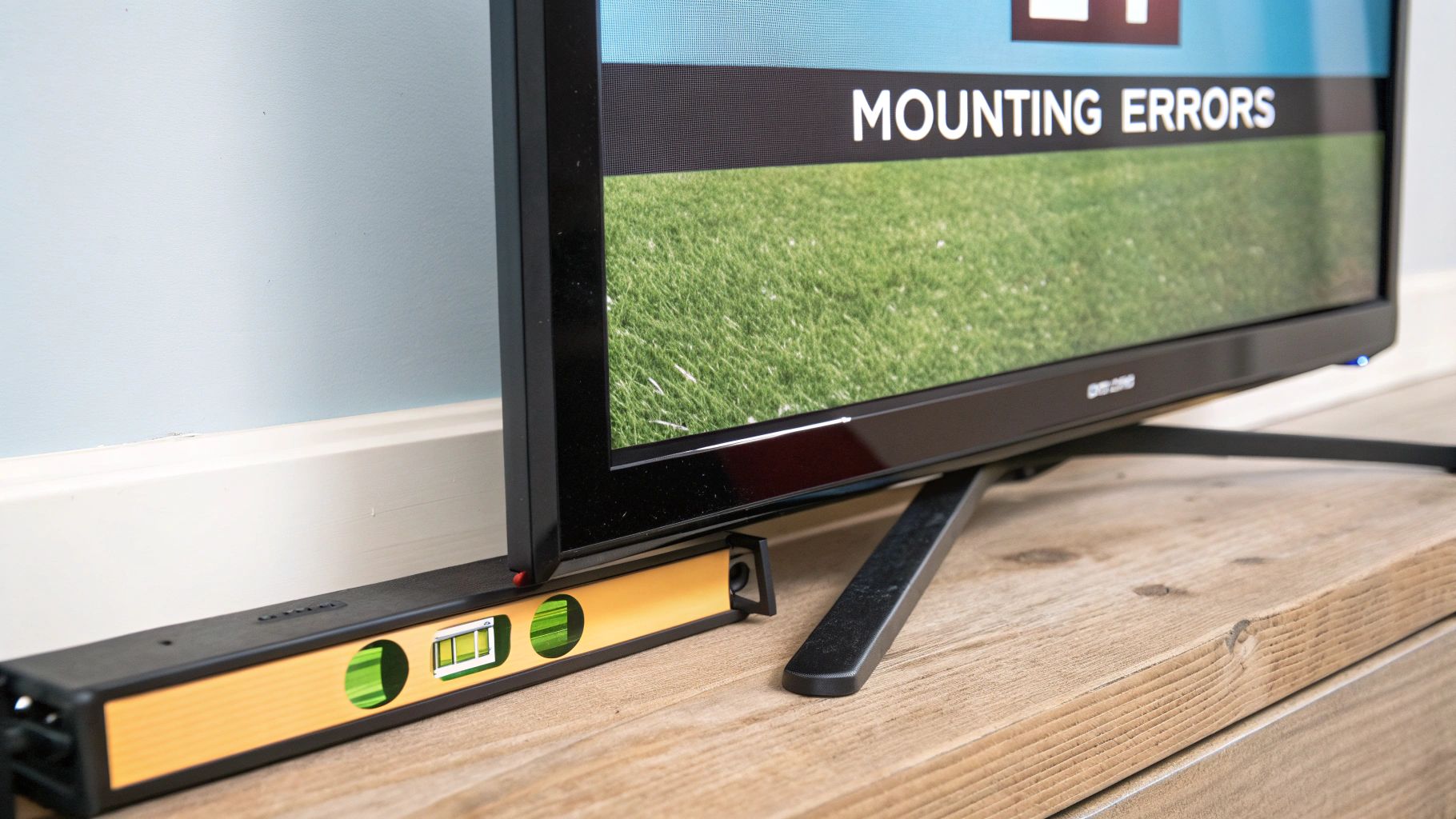
Let's discuss some common TV mounting mistakes. By talking with professional installers, we've identified recurring errors happening in living rooms everywhere. Understanding these issues can help you avoid discomfort and frustration down the line.
The Too-High TV
The most frequent mistake? Mounting the TV too high, often above a fireplace. This might look visually appealing, but it forces viewers to crane their necks, leading to neck strain and headaches. A seemingly harmless design choice can quickly ruin movie night.
The Center-of-the-Wall Trap
Centering the TV on the wall without considering the viewer's eye level is another common blunder. This prioritizes aesthetics over ergonomics, often resulting in a TV that's too high for comfortable viewing. Symmetry is great, but not at the expense of your viewing experience.
Ignoring Furniture Changes
Many homeowners forget how future furniture changes might affect their TV height. A new sofa or recliners can significantly alter the optimal viewing angle. What was once comfortable can become a source of eye and neck strain. Planning for future furniture is crucial for proper TV placement.
Prioritizing Aesthetics Over Ergonomics
Sometimes, the TV's appearance on the wall takes priority over viewing comfort. Mounting the TV too high for a specific aesthetic sacrifices ergonomics. Remember, a TV's primary purpose is viewing enjoyment, not just interior design.
The Permanent Mount Problem
Perhaps the biggest mistake is permanently mounting a TV without testing the height. Adjustments are difficult and costly once it's up. Choosing the right wall mount is crucial, emphasizing careful planning before drilling.
Simple Fixes For Common Mistakes
Fortunately, these mistakes have simple solutions. For TVs mounted too high, a tilting wall mount can angle the screen down, improving the viewing angle. Anticipating furniture changes? Consider an adjustable mount for flexibility to fine-tune the height later. Before permanently mounting, test different heights using a temporary stand or a cardboard cutout. This helps you find the optimal TV height without making permanent holes.
Real-World Examples and Solutions
Imagine a living room with a high fireplace and a low sofa. Mounting the TV above the fireplace seems natural, but it forces viewers to look up. A better solution? Mount the TV lower, or use a stand and angle it slightly upward.
Consider a bedroom with a bed and a recliner. The ideal TV height for each position is different. An adjustable mount is the best solution, letting you change the height depending on whether you are in bed or sitting in the recliner. By understanding these common mistakes and implementing practical solutions, you can create a comfortable and enjoyable TV viewing experience.
DIY vs. Professional Installation: Making The Right Call
After figuring out the best height for your TV, the next important step is installation. Do you handle it yourself, or bring in a professional? This section goes beyond just cost savings and explores the key factors to consider, drawing on insights from DIYers and seasoned installation professionals.
Evaluating Your DIY Skills and Resources
Mounting a TV is more involved than simply screwing it into the wall. Accurate measurements, understanding different wall types, and knowing how to use specific tools are crucial. If you’re comfortable with basic home improvements and have the right tools, a DIY installation might be a good option. But if you’re lacking in experience or equipment, professional installation might be the smarter choice.
- Essential Tools: Stud finder, drill, level, screwdriver, appropriate wall anchors (depending on your wall type), and the mounting hardware that comes with your TV mount.
Safety First: Hidden Risks of DIY Mounting
Safety should always be the top priority. A poorly mounted TV can fall, causing damage and potential injuries. Electrical wiring and plumbing are often hidden inside walls, and hitting one of these during installation can lead to serious problems. Professional installers have the experience and knowledge to avoid these hazards.
When Professional Installation Makes Sense
Some situations really call for professional help. Mounting a very large or heavy TV, dealing with tricky wall types like concrete or brick, or installing in an awkward spot often requires special skills. If your ideal TV height requires complex wiring or integrating other equipment, a professional can ensure a clean and safe setup. If you’re just not comfortable with the process, getting professional help is a good idea. Assembly Smart offers reliable TV mounting services.
The Cost-Benefit Analysis: DIY vs. Professional
DIY installation can certainly save money on labor costs. However, remember to factor in the cost of tools if you don’t already own them. Mistakes during a DIY project can also end up being costly to fix, sometimes even more than professional installation. Consider the value of your time and the peace of mind that comes with professional expertise.
Finding and Vetting Qualified Installers
If you decide to go with professional installation, do your research. Look for installers with proven experience, insurance, and good customer reviews. Get quotes from several installers to compare prices and services. Ask about their experience with different wall types and TV sizes to make sure they can handle your specific needs.
Warning Signs You're In Over Your Head
There are a few signs that indicate you might be better off hiring a professional. Feeling unsure about any part of the process, not having the right tools, or running into unexpected problems during installation are all red flags. Don’t hesitate to call in the experts if you start to feel overwhelmed. Your safety and peace of mind are worth the investment. Learn more in our article about How to master TV wall mount removal.
Making the Final Decision: Your Optimal Choice
The choice between DIY and professional installation ultimately depends on your individual skills, available resources, and comfort level. Carefully consider the factors discussed above – cost, safety, complexity, and your own abilities – to make the best decision for your specific situation and ensure a safe and enjoyable TV viewing experience.
Key Takeaways
This guide provides a practical roadmap for achieving the optimal TV height for your space. We'll cover essential tools, offer a handy checklist, address common troubleshooting issues, and provide maintenance tips to keep your setup in top shape.
Essential Tools and Measurements
Before you start, gather these essential tools:
- Tape Measure: Accurate measurements are crucial for this project.
- Stud Finder: A stud finder is essential for locating wall studs for secure mounting.
- Level: This will ensure your TV is perfectly horizontal.
- Drill: You'll need a drill for pilot holes and securing the mount.
- Screwdriver: Essential for attaching the mount and TV brackets.
- Pencil: Use this to mark measurements and locations on the wall.
Remember, your viewing distance (the distance between your seating area and the wall) and eye-level height (the height of your eyes when seated) are key measurements for determining the optimal TV height.
Checklist for Installation
Follow this checklist for a smooth installation:
- Measure Twice, Drill Once: Double-check all measurements and calculations before drilling any holes.
- Consider Seating: Factor in the eye level of everyone who will be using the room.
- Test Before Committing: If you can, test your chosen height with a temporary setup before permanently mounting the TV.
- Account for Future Changes: Consider potential furniture changes and how they might affect viewing.
Troubleshooting Common Challenges
Here's how to address common issues:
- Neck Strain: If you experience neck strain, the TV is likely mounted too high. Lower it or use a tilting mount.
- Eye Fatigue: Eye fatigue can indicate the TV is either too high or too low. Adjust as needed.
- Glare: Glare usually suggests improper positioning or lighting. Adjust the TV angle or add curtains or blinds.
Maintaining Your Optimal Setup
Follow these tips for long-term viewing comfort:
- Regular Checks: Periodically re-evaluate your setup, especially after rearranging furniture or changing viewing habits.
- Adjustable Mounts: An adjustable mount provides flexibility for fine-tuning the height.
- Cable Management: Keep cables organized and hidden for a clean and safe setup.
Celebrating Your Success
With your TV at the perfect height, enjoy comfortable movie nights, strain-free gaming, and a more immersive experience. Optimal TV height improves both your entertainment and your well-being.
Achieving Long-Term Comfort
Treat optimal TV height as an ongoing process. As your living space and viewing habits change, adjustments may be necessary. Regular checks will ensure lasting comfort.
Creating a Harmonious Viewing Environment
Optimal TV height isn't just about physical comfort; it contributes to a balanced, visually appealing space. A well-placed TV enhances the overall ambiance of your room.
The Impact of Technology on TV Height
Modern TVs differ from older models, impacting optimal height calculations. Consider factors like screen size and resolution. Larger, higher-resolution screens often permit closer viewing, affecting ideal height.
The Importance of Personalized Adjustments
While general guidelines help, personal preferences are key. Individual needs, room layout, and furniture arrangements contribute to finding the perfect height for you.
Ready to upgrade your viewing experience? Explore Mount-It!'s selection of TV mounts.









